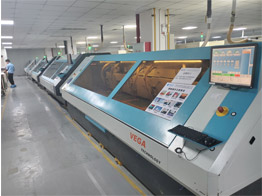Do you Know About Aluminum PCB?
2020-04-08

As a PCB Assembly Company, share with you. Aluminum PCB is a metal-based copper-clad board with good heat dissipation function. Generally, a single panel is composed of a three-layer structure, which is a circuit layer (copper foil), an insulating layer, and a metal base layer. Common in LED lighting products. There are two sides, the white side is soldered with LED pins, and the other side shows the original color of aluminum. Generally, it will be in contact with the thermally conductive part after applying thermal conductive paste. There are ceramic substrates and so on. For high-end use, some are designed as double-sided panels, the structure is circuit layer, insulation layer, aluminum base, insulation layer, circuit layer. Very few applications are multi-layer boards, which can be formed by laminating ordinary multi-layer boards with insulating layers and aluminum bases.
The aluminum LED substrate is a PCB, which also means a printed circuit board, but the material of the circuit board is aluminum alloy. In the past, the material of our general circuit board was glass fiber, but because the LED heat is large, the circuit board used for LED lamps is The aluminum substrate can conduct heat quickly, and the circuit boards used for other equipment or electrical appliances are still fiberglass boards!
The surface of the power device is mounted on the circuit layer. The heat generated during the operation of the device is quickly conducted to the metal base layer through the insulating layer, and then the heat is transferred out by the metal base layer to achieve heat dissipation of the device. A
Compared with the traditional FR-4, the aluminum substrate can minimize the thermal resistance, so that the aluminum substrate has excellent thermal conductivity; compared with the thick film ceramic circuit, its mechanical properties are also excellent.
In addition, the aluminum substrate has the following unique advantages:
Meet RoHs requirements;
More suitable for SMT process;
In the circuit design scheme, the heat diffusion is extremely effectively treated, thereby reducing the operating temperature of the module, extending the service life, and improving the power density and reliability;
Reduce the assembly of radiators and other hardware (including thermal interface materials), reduce product volume, reduce hardware and assembly costs; optimize the combination of power circuits and control circuits;
Replacing fragile ceramic substrates for better mechanical durability.
Our company also hasFlexible PCB for sale, please contact us.
